


Fear stole through the
city of New York like a choking fog. Within five months, nine people had been strangled to
death! And the unknown killer was still at large! Like a savage cat, the murderer pounced
without warning, choosing his victims at random. No one was safe. The City was in a panic! |
|
“Some of the same old stratagems, in a new territory —
psychoanalytical — ,and a more than superior manhunt...”
-- Kirkus Reviews “Cat of Many Tails is most entertaining and spectacular as long as the stranglings keep on their way, but goes dead as soon as psychiatry intervenes.” -- Ralph Partidge, New Statesman & Nation “Whether any series of crimes could so terrorize a city seems questionable. If you take his premise for granted, however, Mr. Queen makes a lively story out of what might happen under such circumstances.” -- New York Herald Tribune “What you will most remember the novel for is its ‘descriptive passages’ and ‘atmospheric’ preoccupations.” If the human characters still betray a touch of the bloodlessness of the Van Dine era, the actual protagonist of the novel, The City of New York, comes magnificently to life.” -- Anthony Boucher, New York Times “Solution is one of those currently fashionable double-edged affairs that can fit two suspects — an ingenious enough finish to an otherwise overinflated story.” -- New Yorker “This is an extraordinary treatment of a baffling series of homicides. . . The chase that finally leads to the identity of the criminal not only keeps the reader on edge, but is told with an eclat that may make this a classic of the genre.” -- D.F.M. Springfield Republican “Here is as high-paced and exciting a detective story as has yet come from the Queen cauldron.” -- Brisbane Telegraph “Dissertations on the effect of the crimes on the city hold the reader in suspense as to when the writer will get on with his story. Yet the book has grip enough to carry the reader through to the final page.” -- The Age, Melbourne “Infinitely ingenious.” -- Maurice Richardson, Observer. “The best 'Queen' for years.” -- Sphere “Ellery... makes a magnificently involved psychological deduction - and makes the mistake of underrating the reasoning powers of the murderer, who happens to have read all the Queen books to good purpose.” -- Evelyn Banks, John o'London's Weekly. “Magnificent.” -- K. John, Illustrated London News. “Wonderful ingenious and grippingly readable.” -- Yorkshire Observer “Vintage Queen.” -- Manchester Daily Dispatch |
     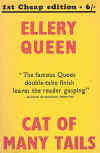 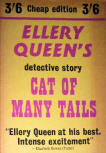 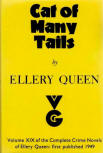 |
| Above left to
right:
dust and 2 hardcovers for Little,
Brown & co., September 1949, hardcover for Little, Brown and co.,
Mystery Guild Library De Luxe edition. Below left to right: dust cover for Gollancz editions (1949, 1952, 1954 and 1974) (Click on the covers to see the differences) * |
| Evening Star, Washington D.C. "Crime and Mystery" by
Miriam Ottenberg
October 9. 1949 "Panic strikes New York. A killer is at large, a stalking fiend who strangles with a cord of India silk-blue for the men, salmon pink for the women. Is this the work of a maniac who picks his victims by chance or is there some plan of destruction in these clueless homicides? Not knowing, New Yorkers flee to the suburbs, riot in terror and otherwise perform in a silly fashion not all complimentary to the good sense of a great metropolis. Enter Ellery Queen forced out of voluntary retirement to look at motives for mass murder. The story, while mechanically smooth, hardly justifies 311 pages in the telling. Queen is always a careful craftsman, but it seems to us he took too long to convince his detective alter ego to get busy and that he let all the air out of his bubble of tension before coming up with his surprise denouement." The Argus, Melbourne - Sweeney Todd's Crime Corner by S. T. December 24. 1949 "HERE is a full-length Ellery Queen and one of the best to date - the story of a mysterious killer, nicknamed The Cat, who strangles nine victims in an apparently capricious way. New York is thrown into a state of panic - an unflattering view of the mentality of this great city, but, after all, the author's, not ours. No doubt in a city which can be terrified by bogyman tales of Martian invasions anything is possible. When the police are baffled, Ellery is called in as Mayor's Special Investigator to allay the fears of hysterical Manhattanites. His unwinding of the mystery makes a tale full of tension. The discovery of the plan behind the sequence of murders is one of the neatest things in crime fiction. Ellery himself is carried a stage further in his process of humanization from the priggish imitation-Englishman of the early stories. Here we find him moaning over his fallibility, and in the last chapters, equipped with a full set of American neuroses, being petted by a benevolent and fatherly Viennese psychologist, who wipes away his tears and tells him to be a brave boy and carry on his work. If the story has a fault, it is that it is over-long. It might well have ended on its apparent climax without the elaborations of a secondary explanation. But that, perhaps, would have been too unsubtle for Ellery. [Note: The other day an American friend said to me, "Why do you say such unpleasant things about America?" It's not I that says them. If American fiction and American films give this sort of picture of the United States, I can only describe it.]" |
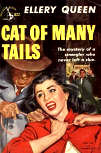       |
| In some of the books, notably Ten Days' Wonder (1948) and Cat of Many Tails (1949), Ellery's actions cause additional deaths, and his anguish over his presumption and intellectual arrogance (he refers to his "first victim" in Ten Days' Wonder) gives these stories additional depth and lasting interest. This book concerning the strangulation murders of six people during a hot summer in New York City, shows the amount of action, psychological insight, and social observation Queen brought to the puzzle mystery. While Ellery and his father try to discern the pattern behind the murders and identify the killer, sensational newspaper and radio coverage whips the public into a frenzy, vigilante groups rise up, and the city bursts into lethal riots. After an exhaustive police investigation and some bravura reasoning by Ellery, the police set a trap for the killer, but before Ellery realizes that they have captured the wrong person, more deaths occur. Ellery resolves to quit his "glorious career of [bumbling] masquerading as exact and omnipotent science," but a wise professor dissuades him, avowing that the "great and true lesson" the detective should learn from the story is, quoting from the Gospel of Mark, "There is one God; and there is none other but He." ("Mystery Men" by S.T.Karnick) |
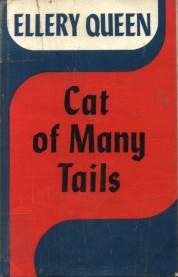  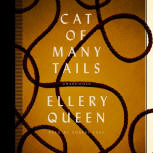 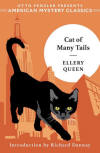 |
|
Carolyn Wheat on
Cat of Many Tails in
Mystery muses: 100 classics that inspire
today's mystery writers, 2006. "Surely the title should have been 'Cat of Nine Tails'. After all, nine people were murdered by the serial killer known as the Cat, who terrorized Manhattan during one hot summer much as the Son of Sam would do in real life years later. Fred Dannay and Manfred B. Lee, writing as Ellery Queen, captured the rising — hysteria of a city gone mad with terror as it waited for the next victim to turn up in Central Park or a subway station. When detective Ellery Queen realized that the victims, who were wholly unrelated to one another, had been murdered in descending order of age, the panic really hit the tabloid fan. The portrait of New York City under pressure from intense heat and growing fear is only one of the reasons 'Cat of Many Tails' has stuck with me for so many years. Even more important to me as a writer is what the case does to Ellery. This Ellery is far different from the condescending thinking machine who made his debut in 1929; this Ellery takes every murder personally. He begins the book in a state of depression triggered by the Van Horn case (Ten Days’ Wonder). 'He had found himself betrayed by his own logic. The old blade had turned suddenly in his hand; he had aimed at the guilty with it and it had run through the innocent.' When he comes out of his self-imposed exile to take the case, he not only matches wits with the Cat, he dedicates every waking moment to capturing the killer before more innocents die. He plunges into despair as he fails to prevent more murders. Nine people are dead when Ellery finally unmasks the Cat — but his victory turns hollow when he discovers the truth behind the truth. Once again his logic skewered the innocent and let the guilty go free. The conclusion of this extraordinary case brings Ellery to the point of despair all over again. For 'the logical This sounds a lot more portentous than it reads on the page. The book is a wonderful glimpse into New York City at the close of the 1940s, and it even has a few things to say about race relations, which is highly unusual in books of the period. Skip the obligatory romantic comedy and keep your eye on Ellery’s manic-depressive mood swings as he wrestles with the puzzle of the Cat killings. We take it for granted today that the detective has personal feelings, but at the time Cat was written, this was not a given. Murder takes its toll and in 'Cat of Many Tails', Ellery Queen the writer gave us a portrait of Ellery Queen the detective that showed the high price he paid for his brilliance. Did he fail again, as he had in the Van Horn case? Up to a point, yes. Does that mean he will stop using his remarkable brain in the service of justice? As a world-famous psychiatrist tells him, 'You have failed before; you will fail again. That is the nature and the role of man.” The great man reminds Ellery “There is but one God, and there is no other but He.' ” |
| A departure for EQ: more of a manhunt than a mystery, although with a
neat twist. There's that extraordinary sequence with Ellery and the
psychiatrist. Michael E. Grost suspects
that the use of the name Casilis is in tribute to Mollie Casilis in Craig Rice's It
Takes a Thief (1943). Despite the fact that Lee felt that this was his best book it
was not published as a serial in a magazine prior to publication. TV-Movie (simplified): Ellery Queen: Don't Look Behind You. Recently chosen by the Members of the Independent Mystery Booksellers Association's online discussion group as one of the "100 Favorite Mysteries of the Century". The title of Italian film director Dario Argento's Il Gatto a Nove Code (1971) was tribute to this Ellery Queen book. |
| The West Australian, Perth
-
December 10. 1949 " 'CAT of Many Tails' relates how the son of the famous Inspector Richard Queen, of the New York Police Department, worked alongside his father in sorting out the facts of a series of strangulations which had caused Manhattan habitués to become unduly afraid. The mass fear had been worked up by some of the newspapers and by radio. In the course of the controversy a philologist stated that 'The Greek word naus, meaning ship, was the mother of nausea, and that noise was fruit of the same womb,' and he wept on 'with pedantic satisfaction to cite some etymological authorities to the effect that the word news probably had the same parent.' This is a holding book." The Herald, Melbourne - "Crime Marches On: The Cat and Mr. Queen" October 29. 1949 by A. R. McElwain "MR. ELLERY QUEEN has done more contemporary expert to keep the student abreast of crime trends and authentic detection methods. Our learned and prodigious colleague until recently has been engaged on the monumental task of classifying crimes (recorded in the shorter form) according to the phases of life to which they are related. Now he gives us a full-length record of horrible mass murders perpetrated by a fiend called the Cat. The Cat, while it prowls and strikes, terrorizes New York very much in the way our celebrated friend, Jack the Ripper, threw London into the Jitters some years ago. The Cat has nine lives to its grisly credit. All the victims— mostly women— are related, in an odd way, to one person. And all are strangled, Indian fashion, by a silk cord— a blue cord for males, salmon-colored one for females. The paranoiac murderer works strictly to routine, leaves, apart always from a corpse and a cord, no clues. He almost floors Queen— but not quite, because Mr. Queen is a firm believer in Daniel Webster's notable dictum: "Every unpunished murder takes away something from the security of every man's life." He goes into the case in that frame of mind— and he cages the Cat before it can add a tenth tail to its awful score. I commend this complicated case, with its heavy, accent on psychology and neurosis, to the advanced student as one of the most ingeniously constructed and brilliantly solved Mr. Queen has given us. 'Cat of Many Tails' underlines heavily that gift Mr. Queen has demonstrated these many years— the ability not only to do things to our spines but also to our minds." |

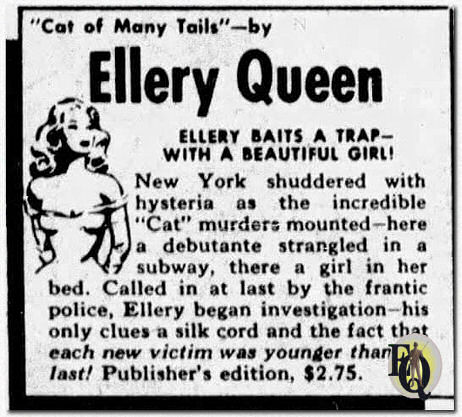 |
|
Cat of Many Tails Translations: |
|
Other articles on this book (1) Reading Ellery Queen - Cat of Many Tails Jon Mathewson (Apr 2015) (2) My Case -『揺れる警視庁1200万人の人質』 Ho-Ling (June 2011) (3) At the scene of the crime -Cat among the pigeons Patrick (Mar 2012) (4) Dead Yesterday (Aug 2019) (5) Day 61, plus thoughts about Ellery Queen's Cat of Many Tails - Sarah/Katherine (truepenny), (Sep 2010) (6) What Makes a Good Serial Killer Mystery? A Review of Cat of Many Tails (1949) Kate Jackson at crossexaminecrime (Jun 2025) (7) Cat of Many Tails by Ellery Queen (1949) gaodf (Summer 2025) (8) Cat of Many Tails, Stephen M. Pierce (Apr 21. 2025) - spoilers! |
|
*
Interested readers should know
that the icons/covers
of books, used throughout the
website have extra
descriptions/information not
included in the text on the same
page. Pointing your cursor at
the icon/cover used to reveal
this extra information. To achieve the same effect Firefox users can install an add-on called 'Popup ALT Attribute'. When installed pointing your cursor at an icon/cover results in showing you the details or additional information. |
|
Copyright © MCMXCIX-MMXXV Ellery Queen, a website on deduction. All rights reserved. |